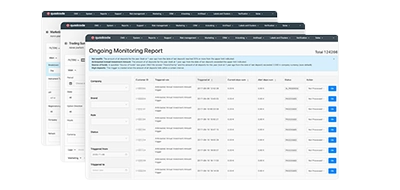Voltar
Contents
O que é o indicador ADX e como usá-lo?

Vitaly Makarenko
Chief Commercial Officer

Demetris Makrides
Senior Business Development Manager
O indicador de índice direcional médio (ADX) serve como uma ferramenta para avaliar a força de uma tendência de mercado, com foco em sua intensidade e não em sua direção, seja ela ascendente ou descendente. Os traders valorizam muito o indicador ADX por sua confiabilidade e versatilidade, utilizando-o com frequência em mercados como ações, futuros e fundos mútuos.
Lendo o Indicador ADX
O ADX é representado por uma única linha que se estende de zero a cem. Indicando a força de uma tendência, independentemente de os preços estarem subindo ou descendo, o ADX é um indicador não direcional.
Composto por três linhas — a linha ADX, o Indicador Direcional Positivo +DI e o Indicador Direcional Negativo DI — uma leitura acima de 25 sinaliza uma tendência, enquanto abaixo de 25 sugere uma tendência ou movimento lateral dentro de um intervalo específico.
O indicador ADX produz uma linha que representa fielmente a intensidade e a amplitude da tendência. Com uma pontuação acima de 25, uma tendência significativamente forte é mostrada. A tendência pode estar se movendo para cima ou para baixo, dependendo das posições relativas das linhas +DI e -DI. Quando a pontuação ADX cair abaixo de 0, os traders devem proceder com cautela. Isso geralmente sugere que o mercado começou a se mover em uma tendência fraca ou entrou em movimento dentro de uma faixa. Os traders devem ignorar esses sinais e evitar táticas de negociação baseadas em tendências de mercado, considerando as circunstâncias atuais.
Como resultado, os traders extraem sinais de negociação da interação das linhas +DI e -DI. Se a linha ADX estiver subindo e a linha +DI tiver ultrapassado a linha -DI, os traders podem presumir que uma tendência de alta está prestes a começar. O inverso também é verdadeiro: quando os traders veem a linha -DI subindo acima da linha +DI e a linha ADX caindo, eles interpretam isso como o início de uma tendência de baixa.
Limitações do ADX
Embora o indicador ADX tenha diversas aplicações benéficas, é crucial reconhecer suas limitações. Como mencionado anteriormente, ele é um indicador defasado, o que significa que depende de dados históricos de preços e movimentos. Consequentemente, ele não reage prontamente a mudanças e oscilações nas condições de mercado. Esse problema pode levar à perda de sinais ou a entradas atrasadas, especialmente em mercados voláteis com muitas oscilações rápidas.
E, como mencionado acima, como o ADX não mostra a direção do mercado, apenas a força, ele precisa ser usado com outros indicadores para obter insights sobre a direção do mercado e da tendência. Além disso, tentar entender a linha do ADX e sua interação com as linhas +DI e -DI pode ser complicado. É preciso alguma experiência e um bom entendimento do mercado para manejar este ADX com eficácia e entender sua leitura no contexto do mercado.
Usando o Indicador ADX
O indicador ADX tem inúmeras aplicações além de apenas ajudar os traders a avaliar a força da tendência. Quando combinado com outros indicadores, ele oferece aos traders a possibilidade de obter uma grande quantidade de informações úteis que podem ajudá-los a aprimorar suas estratégias de entrada e saída de operações. Uma aplicação do indicador ADX diz respeito a um padrão de divergência.
Isso acontece quando o ADX mostra uma tendência em uma direção, mas o preço de um ativo se move na direção oposta. Isso significa uma possível mudança na intensidade da tendência. Se um trader observar um preço de um ativo específico subindo, mas acompanhado de uma linha ADX em queda, isso é um possível indício de que a tendência de alta está chegando ao fim. Consequentemente, ele pode considerar este um momento oportuno para garantir ganhos com a operação.
Ao tentar determinar se um rompimento é falso, os traders costumam usar o ADX. Os formadores de mercado costumam usar rompimentos falsos como uma tática enganosa, especialmente em mercados altamente voláteis, como o de criptomoedas. A ação do preço pode ser forte o suficiente para romper níveis de suporte ou resistência, revertendo e retornando. Abrir uma operação com base em um rompimento falso pode resultar em perdas financeiras significativas. No entanto, o indicador ADX pode ser usado para mitigar esse risco.
Antes de iniciar uma transação, um trader pode analisar o número ADX. Se a leitura estiver abaixo de 25, isso indica que o rompimento provavelmente é falso e que o mercado não possui a força necessária para sustentá-lo. Isso sugere que uma reversão é provável. Por outro lado, se o trader observar uma leitura acima de 25, indicando uma tendência de mercado robusta, ele pode entrar em uma posição com mais segurança, antecipando a continuidade do momentum do mercado.
Conclusão
O indicador ADX é uma ferramenta eficaz para avaliar com precisão a força de uma tendência de mercado, quando utilizado corretamente. Assim como qualquer outra ferramenta, instrumento e indicador, os indicadores ADX funcionam melhor quando combinados com outras ferramentas. Isso permitirá uma visão geral mais completa do mercado e decisões mais acertadas. Os traders que conseguem aprender, compreender e aplicar este indicador, juntamente com seus pontos fortes e fracos, podem operar com confiança e precisão, resultando em mais lucros e um resultado financeiro melhor.
Atualizado:
19 de dezembro de 2024




